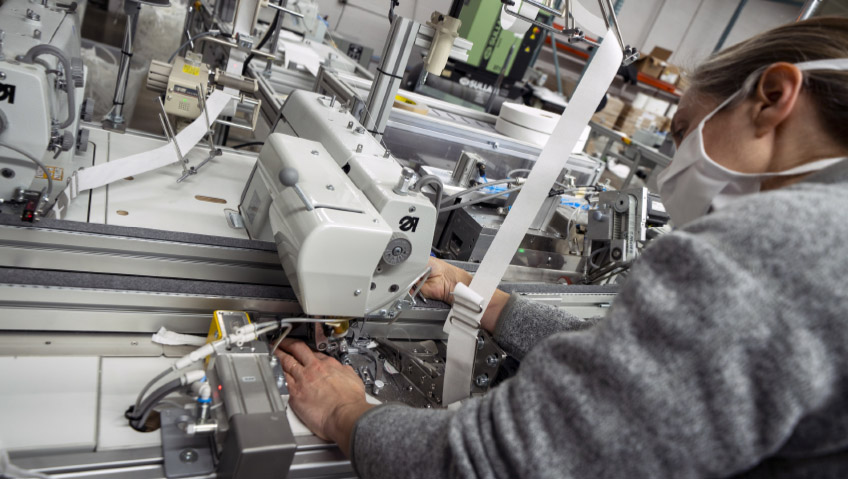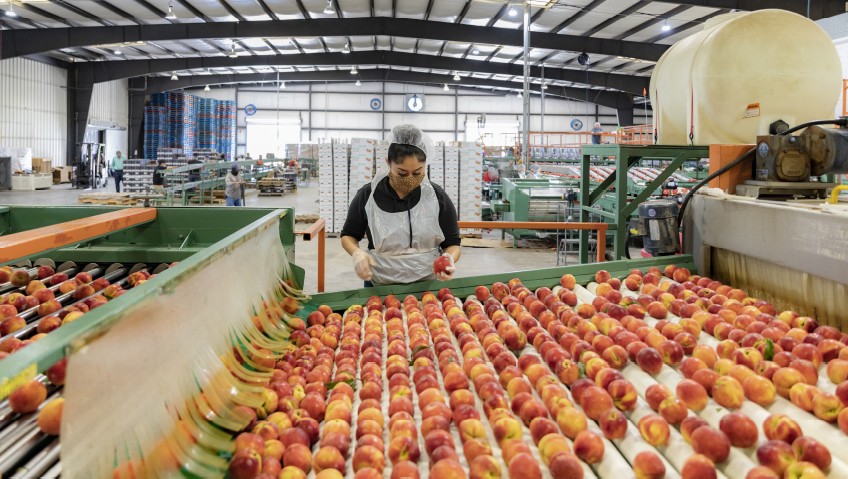DAP stands for more than Dürkopp Adler Pfaff. The acronym also reminds one of the Dutch word ‘dapper’ which far transcends its English variant’s sense of elegance and neatness to express boldness, strength, and sturdiness. This is exactly what DAP America, headquartered in Peachtree Corners, Georgia, displayed during the pandemic.
DAP America’s parent company is in Bielefeld, Germany and has three primary manufacturing plants in the Czech Republic, Romania, and China, alongside subsidiaries in Southern and Central Europe trading as DAP Italy, DAP France, and DAP Poland, all handling distribution. DAP America trades throughout Canada, the United States, and Mexico, as far south as Argentina, providing sales, field service, applications consulting and technical support.
Brands represented include Dürkopp Adler, Pfaff, and KSL, while its variety of technologies accounts for industrial processes such as automated sewing stations, sophisticated software, and robotic systems. These offerings ensure flow improvement and allow for generous margins resulting from the quality stitching needed to make products with the luxury edge that discerning users demand.
In 2018, we reported on how our world is held together by DAP America’s renowned sewing technology. Little did anyone know then that the industrial sewing giant’s innovation would soon also be responsible for holding together the personal protective equipment (PPE) that would ultimately save the lives of many Americans.
There is hardly an aspect of its business that did not see an epic 2019–2020 thanks to the leap that COVID-19 spurred in the firm’s capabilities. As fate and fortune would have it, this company held the key to what has arguably become the hottest mask manufacturing technology in the world. Creating this unique machinery has changed how masks are made.
“Given our technologies, we were able to make a couple of plays that helped us to stay financially viable and healthy in that sense and, more importantly, being able to safeguard citizens against the public health challenge of COVID-19,” says DAP America President Mariano Amezcua.
While everyone knows and understands old-fashioned sewing, fabric welding is a new method used on specialized fabrics. “To a certain extent, [fabric welding] has been a bit of a niche technology. For example, the Crew Dragon Demo-2 space mission’s space suits were made with PFAFF Industrial welding equipment. So it’s always been a bit of a high-tech, unique niche application,” says Amezcua. The method is increasingly used on polymer-based personal protection equipment (PPE) to protect the integrity of seams and thus prevent the spread of the virus to healthcare workers and first responders.
The company works with partners that are known for pushing the boundaries of fabric and design. DAP America had collaborated with one of these esteemed partners, The University of Cincinnati College of Design Architecture Art and Planning (DAAP), before COVID-19. As DAAP is one of the twenty best international design schools, DAP America would have been hard-pressed to find a better partner.
“They’re one of the premier institutes when it comes to design in academia. We had partnered with them before, giving them some of our technology that they [then] had on hand. [With the pandemic], they immediately rose to the challenge by experimenting and working with their local community to support initiatives,” says Amezcua. As soon as COVID-19 hit, the University of Cincinnati’s DAAP team got straight to work to design and develop a superior face mask.
The project was led by Professor Ashley Newsome Kubley, head of the Evelyn G. Burgoyne Fashion Technology Center and assistant professor of fashion design at the Myron E. Ullman Jr. School of Design at The University of Cincinnati College of Design Architecture Art and Planning. The Fashion Technology Center started to take shape toward the end of 2018, driven by the globalization and automation of the fashion industry.
“This center was started on the feedback we [received] from our industry partners and the fact that the fashion industry and the design industry were changing and moving toward technology-driven initiatives and integration of automation,” says Kubley. The professor then led an initiative to make the latest equipment and technology available to students, giving them hands-on experience with industry-standard machines and knowledge to empower them in their roles when they enter the apparel job market.
Allowing students to spend time learning contemporary skills brings the college’s curriculum in line with the university’s cooperative education program that expects students to commit to compulsory internships in their field of study spaced over alternate semesters during their undergraduate and graduate courses. “Our university is very connected to industry because students have five internships throughout their undergraduate degree over five years. They go to different companies all around the country and all around the world, actually working and getting paid to be designers before they graduate,” Kubley says.
The Fashion Technology Center is the home of a PFAFF 8312 ultrasonic welding machine and an 8303i that does continuous seam welding. The idea came about when DAP America President Amezcua and The Myron E. Ullman, Jr. School of Design’s Endowed Chair and Director Dr. Gjoko Muratovski agreed that the machines would be a decidedly positive addition to the school’s facilities. “The machines [have given] students a huge opportunity to learn a brand new, specific, useful, and relevant technology. This is of particular interest to students who are interested in designing activewear, outerwear, footwear, and other applications that are PPE-related, so things for workwear,” Kubley says.
By the time the reality of the effects of the COVID-19 virus struck home, the machines had not been onsite long. “All the students were learning, day and night. [Then] everything came to a grinding halt all at once. Although sales and industry felt like it was stopping, education kept on going,” says Kubley. It was time to strategize. Setting up the machines had demanded a significant capital outlay, and now they risked remaining dormant until normalcy returned.
Research and production could go on, however. Kubley joined in a mission to devise a strategy that would see PPE produced and delivered to first responders, medical and healthcare workers, people working in primary care facilities, educators, and other essential service providers serving in the University of Cincinnati’s networks and beyond.
“We [could create] a seamless union [between] two polymers [through] some heat source that prevents the penetration of the COVID virus [to] protect the health and safety of our healthcare workers that were [and still are] fighting the good fight,” Amezcua says.
It was an exhilarating time, although challenges were plenty. Traditional sewing causes perforations that can potentially offer the COVID-19 virus admission to the wearer’s respiratory system. Instead, PFAFF Industrial machines fused fabrics without stitches, and this method was the best way to create large volumes of masks, fast. With very few other materials to work with due to the lockdown and a goal of creating two thousand masks in a month, Kubley and her team had their work cut out. Several partners made valuable donations of fabric and other construction materials for the masks.
“We dialed the process into the ultrasonic sewing machine. Every aspect of the construction of the mask was done with the welding machine. We laser-cut all the pattern shapes for the actual mask design itself, and then we used the ultrasonic welding machine to create this fused seam in the front which makes the mask air-tight and the shape is a lot more comfortable to wear than conventional pleated masks,” Kubley tells us. The team was unable to find elastic, which meant that the bindings were also laser cut while a clever, easy-to-follow guideline gave helpers an intuitive pattern of sorts that they could follow as they fed the masks to the machine.
DAAP reached its goal of delivering two thousand masks in a month: one thousand disposable and one thousand washable. Three thousand more followed, and over forty people were trained to use the equipment. The PFAFF Industrial welding machine is so simple to operate that even those usually reluctant to use industrial machines lost their reserve when they realized how easy it was to use this technology. Not everyone who helped sew masks knew how to sew. Volunteers, engineering students, and industrial design students could pitch in to make masks using the ultrasonic welding machine.
Today, research continues into new fabric welding applications. One example, raised by Amezcua, is the rideshare movement, where fabric contamination from paper cuts to pets or children becoming unwell is a genuine concern, and navigating the often exotic microbiomes of public vehicles is an issue that needs serious consideration. “Due to the social trends where we’re going into this rideshare type of community, I see [the] automotive [industry] looking more and more at how [to] use the fabric welding technology in the production of automotive interiors,” says Amezcua.
The company’s next great achievement of 2020 was the automated face mask making machines it created and delivered to the state of Ohio in record time. The machines were fabricated in Europe and assembled in the U.S. “We went from a napkin sketch to loading a fully automated [ready to assemble] system onto a plane within roughly six weeks,” says Amezcua.
Based in Cleveland, Ohio, the Manufacturing Advocacy and Growth Network (Magnet) assists small to medium-sized manufacturers in Northern Ohio with varying levels of assistance to help boost their effectiveness and profitability in the state of Ohio. At the start of the pandemic, the group was mandated to act as an intermediary between the governor’s office, hospital system, and the state’s manufacturing industry. The aim was to drive the transition from standard manufacturing to PPE manufacturing. Carla Macklin was a consultant on the Magnet task force that assisted manufacturers in fabricating masks, helping with everything from creating patterns to sharing sewing know-how.
“Through this consulting project, Magnet, along with the state, identified that there was going to be a gap in what the manufacturers could produce in terms of cotton face masks and what the state wanted to buy immediately. Even after [converting] twelve manufacturers to start making masks, [they were] still millions of masks short in meeting Ohio’s demand,” she says. The state of Ohio turned to Dürkopp Adler to help with that. “It truly was incredible to watch a concept of a mask shared via sketches turn into a piece of automated equipment that could produce huge volumes of these masks within about six weeks,” Macklin adds.
The speed at which this project came to life was nothing short of breathtaking. On the day of our interview in May this year, Buckeye Mask Company’s fabrication count stood at 8.14 million masks, and in collaboration with its partner Stitches U.S.A., 65,000 masks are produced by nine automated machines in any given sixteen-hour workday. For machines in the testing phase that landed on 1 August 2020, that is a phenomenal performance by anybody’s standards.
“This was a unique request. When we got it, we didn’t necessarily have a system in place. We [had] weekly or twice weekly conference calls with Germany and the folks up in Ohio figuring out how to possibly do this. We had never built a system like this. This group wanted North American-based manufacturing with top-quality German manufacturing to support them,” says Amezcua.
The state of Ohio set the bar rather high – they challenged Dürkopp Adler to create a never-before-seen automated fabric mask system that not only would be more cost-effective per use and more sustainable than disposables, but also capable of delivering on a ten-million mask contract. The cotton, reusable masks needed to be washable and durable so that the state’s workforce could get back to their jobs. An all-hands effort included the support of a local senator who requested approval from the state department so that the company’s German technicians could fly to Ohio to assist in initial set-up and machine start-up.
Considering that it took around fifty people to bring this to life across continents brings home the importance of combining technology with teamwork and vision. Once again, DAP America leads the world of sewing into a new epoch with style, determination, and state-of-the-art technology.






